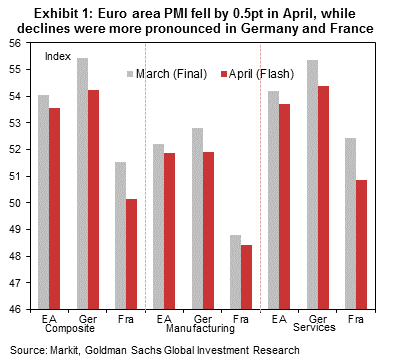Today is shaping up to be a rerun of yesterday where another frenzied Asian session that has seen both the Shanghai Composite and the Nikkei close higher yet again (following the weakest Chinese HSBC mfg PMI in one year which in an upside down world means more easing and thus higher stocks) has for now led to lower US equity futures with the driver, at least in the early session, being a statement by the BOJ’s Kuroda that there’s a “possibility” the Bank of Japan’s 2% inflation target will be delayed and may occur in April 2016.
This official admission of failure (first of many) by the central bank that it won’t be able to reach 2% inflation by its stated year-end goal, clearly reduces expectations of additional easing on April 30, according to Shinkin Asset Management. And in a world without EPS growth (and outright revenue declines) in which every PE multiple expansion turn is driven by some incremental central bank easing (preferably sooner rather than later), less easing is bad for risk, which may explain why US futures are red, if only for now: we fully expect a momentum ignition wave in the USDJPY to promptly push the pair above 120, and take the S&P with it to new all time highs on nothing but correlation algos, either at the usual ramp time of 8:30 am or just before the US market open.One just has to think like a criminal algo.
Meanwhile, “recovering” Europe also fired the first shot across the QE bow, reminding everyone that soaring stock markets have nothing to do with the underlying economies, as Europe’s PMIs disappointed across the board. As Goldman summarizes, the Euro area flash composite PMI fell by 0.5pt to 53.5 in April, below consensus expectations of a modest gain (Cons: 54.4, GS: 54.2). This was the first decline since November. The manufacturing and services subcomponents were both weaker on the month, declining 0.3pt and by 0.5pt respectively. On a national level, composite PMIs for April fell both in Germany (by 1.2pt) and in France (by 1.3pt).

Â

Â

As closer look at Asia reveals that that equities mostly rose with Chinese bourses at the forefront, in the wake of further disappointing Chinese data. Chinese HSBC flash Mfg PMI tumbled to a 12-month low at 49.2 vs. Exp. 49.6, the 4th consecutive month of contraction. Shanghai Comp (+0.4%) and Hang Seng (-0.4%) traded higher for most of the session as the data supports the case for more government easing. Nikkei 225 (+0.3%) extended on its 15yr peak after finishing yesterday’s session above 20,000 for the first time since Apr’00. JGBs fell after prices followed through yesterday’s global fixed income sell-off, although further downside was capped by a poor 40yr auction which attracted the lowest b/c since Aug’14.
Despite opening modestly higher, European equities have been dragged lower following a slew of lacklustre Eurozone PMI data with German and France setting a downbeat tone for the session after missing expectations on manufacturing, services and composite readings. This has also been coupled with underperformance in tech names after Ericsson posted a disappointing pre-market update, ASML paring yesterday’s gains and Texas Instruments in the US posting a disappointing after-market update, while Allianz warned of a potential stock market crash. Additionally, concerns over Greece continue to linger with reports in Handelsblatt suggesting the ECB’s patience has been tested and there are no agreements with Greece on the horizon.
From a fixed income perspective, Bunds have seen a pullback of yesterday’s heavy Gilt-inspired losses, with the move to the upside also provided a boost by the softness seen in European equities.
In FX markets, the USD-index was initially seen higher in earlier trade before being dragged lower to relatively unchanged levels alongside the softness seen in US yields. Elsewhere, AUD remains softer in the wake of the disappointing Chinese HSBC flash manufacturing PMI, with NZD also weaker following dovish rhetoric from RBNZ’s Asst. Gov. McDermott, who said weaker demand and prices would prompt consideration of a rate cut. Finally, UK retail sales weighed on GBP after missing expectations with the ONS saying the 6.2% drop in fuel sales in March was the largest since April 2012.

